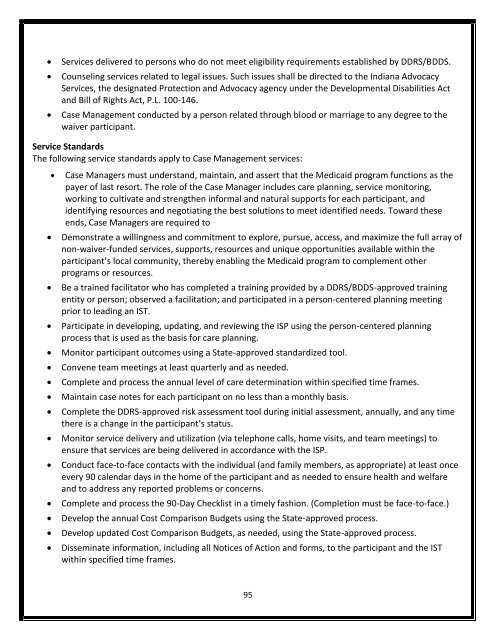DDRS Waiver Manual
2dXf5Pj
2dXf5Pj
Create successful ePaper yourself
Turn your PDF publications into a flip-book with our unique Google optimized e-Paper software.
Services delivered to persons who do not meet eligibility requirements established by <strong>DDRS</strong>/BDDS.<br />
Counseling services related to legal issues. Such issues shall be directed to the Indiana Advocacy<br />
Services, the designated Protection and Advocacy agency under the Developmental Disabilities Act<br />
and Bill of Rights Act, P.L. 100-146.<br />
Case Management conducted by a person related through blood or marriage to any degree to the<br />
waiver participant.<br />
Service Standards<br />
The following service standards apply to Case Management services:<br />
<br />
<br />
<br />
<br />
<br />
<br />
<br />
<br />
<br />
<br />
<br />
<br />
<br />
<br />
<br />
Case Managers must understand, maintain, and assert that the Medicaid program functions as the<br />
payer of last resort. The role of the Case Manager includes care planning, service monitoring,<br />
working to cultivate and strengthen informal and natural supports for each participant, and<br />
identifying resources and negotiating the best solutions to meet identified needs. Toward these<br />
ends, Case Managers are required to<br />
Demonstrate a willingness and commitment to explore, pursue, access, and maximize the full array of<br />
non-waiver-funded services, supports, resources and unique opportunities available within the<br />
participant’s local community, thereby enabling the Medicaid program to complement other<br />
programs or resources.<br />
Be a trained facilitator who has completed a training provided by a <strong>DDRS</strong>/BDDS-approved training<br />
entity or person; observed a facilitation; and participated in a person-centered planning meeting<br />
prior to leading an IST.<br />
Participate in developing, updating, and reviewing the ISP using the person-centered planning<br />
process that is used as the basis for care planning.<br />
Monitor participant outcomes using a State-approved standardized tool.<br />
Convene team meetings at least quarterly and as needed.<br />
Complete and process the annual level of care determination within specified time frames.<br />
Maintain case notes for each participant on no less than a monthly basis.<br />
Complete the <strong>DDRS</strong>-approved risk assessment tool during initial assessment, annually, and any time<br />
there is a change in the participant’s status.<br />
Monitor service delivery and utilization (via telephone calls, home visits, and team meetings) to<br />
ensure that services are being delivered in accordance with the ISP.<br />
Conduct face-to-face contacts with the individual (and family members, as appropriate) at least once<br />
every 90 calendar days in the home of the participant and as needed to ensure health and welfare<br />
and to address any reported problems or concerns.<br />
Complete and process the 90-Day Checklist in a timely fashion. (Completion must be face-to-face.)<br />
Develop the annual Cost Comparison Budgets using the State-approved process.<br />
Develop updated Cost Comparison Budgets, as needed, using the State-approved process.<br />
Disseminate information, including all Notices of Action and forms, to the participant and the IST<br />
within specified time frames.<br />
95


